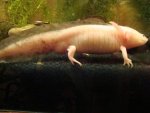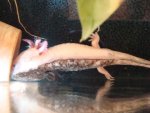-
Axolotls are illegal in California. Please read this thread for detailed information and links to the actual laws: https://www.caudata.org/threads/axolotls-are-illegal-in-california-here-are-the-relevant-laws.30779/
-
Did you know that registered users see fewer ads? Register today!
You are using an out of date browser. It may not display this or other websites correctly.
You should upgrade or use an alternative browser.
You should upgrade or use an alternative browser.
Remarkable Axolotl Coloration
- Thread starter blueberlin
- Start date
Jake
Well-known member
- Joined
- Nov 1, 2006
- Messages
- 1,635
- Reaction score
- 87
- Points
- 48
- Location
- Illinois, US
- Country
- United States
- Display Name
- Jacob Bidinger
looks like pirate but more pronounced.
MUCH more pronounced! What sex is this axolotl, or is it too young to say? Pirate seems to be a hermaphrodite, I honestly can't tell the sex on him/her, but either way I'll set it up to mate with it's father or it's aunt. As previously stated, this is almost definitely not a genetic trait, but an accidental mutation. It is, however, a very beautiful creature. The larval pic looks much like Pirate as a larva (see the link below).
http://www.caudata.org/forum/showthread.php?t=45802&highlight=Pirate
- Joined
- Feb 6, 2001
- Messages
- 8,171
- Reaction score
- 441
- Points
- 83
- Age
- 47
- Location
- USA
- Country
- Ireland
- Display Name
- John Clare
If you believe that, I've got a bridge in Brooklyn to sell you.In this case mother nature did the splicing and recombining herself.
Daniel
Site Contributor
- Joined
- Aug 15, 2007
- Messages
- 664
- Reaction score
- 26
- Points
- 0
- Location
- Germany
- Country
- Germany
- Display Name
- Daniel
If you believe that, I've got a bridge in Brooklyn to sell you.
Well, John - I run the (German) forum the pictures were posted on the first time and I know the person who owns this animal. And if I am not completely fooled by this person (and I do not think so), it has to be mother nature.
- Joined
- Feb 6, 2001
- Messages
- 8,171
- Reaction score
- 441
- Points
- 83
- Age
- 47
- Location
- USA
- Country
- Ireland
- Display Name
- John Clare
This is mother nature in action: http://www.caudata.org/forum/showthread.php?t=45802
sherrisixxx
Member
- Joined
- Nov 28, 2005
- Messages
- 716
- Reaction score
- 5
- Points
- 18
- Location
- London,UK
- Country
- United Kingdom
- Display Name
- Sherri
Totally amazing! Wow, never seen anything like this 
Tim S
New member
Your Axolotl could be a haploid/diploid mosaic resulting from gynogenetic development with the sperm genome combining with the maternal genome after the first cell division. A beast similar to yours can be seen in an article be Fankhauser and Humphrey's (1959) J. Exp. Zool. 142: 379-421.
Kiowa
New member
- Joined
- May 8, 2008
- Messages
- 107
- Reaction score
- 5
- Points
- 0
- Location
- Desert Country
- Country
- Australia
- Display Name
- Kirst
Dickschaedel is truely beautiful and amazing.
featherbutt
New member
- Joined
- May 7, 2007
- Messages
- 117
- Reaction score
- 8
- Points
- 0
- Age
- 44
- Location
- Okanagan
- Country
- Canada
- Display Name
- Mitch Guilderson
I think chimerisim in larval salamanders is probably more common than we realize.
You just cant tell unless the extremely unlikely event that the two zygotes combined are different colors.
Besides this bilateral expression of possible chimerism, there are also labratory-made chimeras that express a division across the body.
theoretically. you could produce quarter, eighth and even checkered 16ths if you selectively exchanged cells during the early embryogenesis divisions.
THAT would be frankencool!
You just cant tell unless the extremely unlikely event that the two zygotes combined are different colors.
Besides this bilateral expression of possible chimerism, there are also labratory-made chimeras that express a division across the body.
theoretically. you could produce quarter, eighth and even checkered 16ths if you selectively exchanged cells during the early embryogenesis divisions.
THAT would be frankencool!
oceanblue
New member
I can accept that this is a natural chimera. Because of the way the neural crest develops as a rolling fold into the neural tube to get this appearance artificially you would need to combine cells very early - two, four or eight cells - chopping down the neural crest would be almost impossible: later artificial chimeras are all head one colour tail another.
If this is a haploid/diploid mosaic then the haploid bit is the leucistic side.
The egg had only the white allele and the normal gene was sperm derived. Careful comparison of the pigment spots on the leucistic side with its siblings should show the pigment cells are smaller than those on diploid leucistic siblings. The definative way to prove its genetics is to chop bits off for chromosome analysis (tip of tail is favourite but here tips of gill look appropriate)- this would be interesting but wouldn't do it any good - a problem for the ethics section.
If this is a haploid/diploid mosaic then the haploid bit is the leucistic side.
The egg had only the white allele and the normal gene was sperm derived. Careful comparison of the pigment spots on the leucistic side with its siblings should show the pigment cells are smaller than those on diploid leucistic siblings. The definative way to prove its genetics is to chop bits off for chromosome analysis (tip of tail is favourite but here tips of gill look appropriate)- this would be interesting but wouldn't do it any good - a problem for the ethics section.
briannashea
New member
wowww...I'm new to axies but that still blows my mind, definitely a rarity  sweet post
sweet post
bob2143
New member
- Joined
- Nov 6, 2008
- Messages
- 47
- Reaction score
- 0
- Points
- 0
- Location
- Hobart, Tasmania
- Country
- Australia
- Display Name
- Muffin + Crumpet + Waffle
That is the coolest thing i have ever seen!!

Last edited by a moderator:
TicTacJunkie
New member
- Joined
- Nov 9, 2008
- Messages
- 12
- Reaction score
- 0
- Points
- 0
- Country
- United Kingdom
so beautiful!!
my axies have some patches but not a straight line down the middle!
WOW
little high
New member
- Joined
- Jul 13, 2008
- Messages
- 62
- Reaction score
- 1
- Points
- 0
- Location
- Gold Coast, Australia
- Country
- Australia
- Display Name
- Nat
He is absolutely amazing.....so very very gorgeous and ying yang like hehehehe 
Gingrich
New member
- Joined
- Nov 25, 2007
- Messages
- 71
- Reaction score
- 1
- Points
- 0
- Location
- Charlottesville, VA
- Country
- United States
- Display Name
- Oskar
That's really cool! It reminds me of those lobsters that have a different color on each side.
blueberlin
2010 Research Grant Donor
- Joined
- Apr 23, 2008
- Messages
- 1,939
- Reaction score
- 51
- Points
- 0
- Age
- 54
- Location
- Illinois
- Country
- United States
- Display Name
- Eva
Hi all,
I am back with permission to upload some updates of Dickschaedel. As you can see, Dickschaedel has grown nicely all these months into a handsome axolotl. The last two pics lead to my next question. Someone on the German forum mentioned that a chimera will be sterile; has anyone here heard of that? Interestingly - well, look at the pictures of Dickschaedel from the white and from the dark side. Notice anything?
-Eva
I am back with permission to upload some updates of Dickschaedel. As you can see, Dickschaedel has grown nicely all these months into a handsome axolotl. The last two pics lead to my next question. Someone on the German forum mentioned that a chimera will be sterile; has anyone here heard of that? Interestingly - well, look at the pictures of Dickschaedel from the white and from the dark side. Notice anything?
-Eva
Attachments
General chit-chat
- No one is chatting at the moment.





